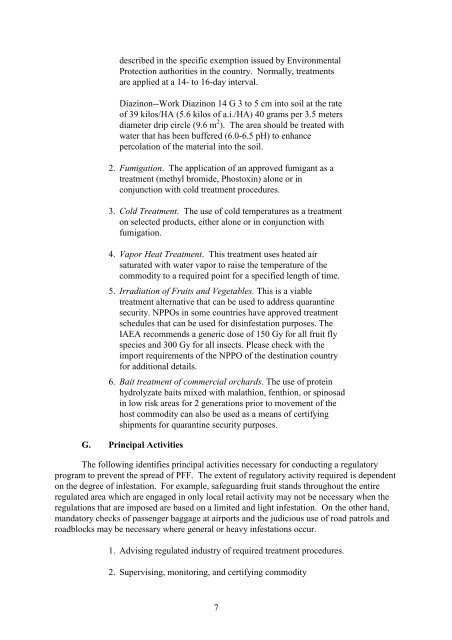Action Plan Peach Fruit Fly Bactrocera zonata - Nuclear Sciences ...
Action Plan Peach Fruit Fly Bactrocera zonata - Nuclear Sciences ...
Action Plan Peach Fruit Fly Bactrocera zonata - Nuclear Sciences ...
Create successful ePaper yourself
Turn your PDF publications into a flip-book with our unique Google optimized e-Paper software.
described in the specific exemption issued by Environmental<br />
Protection authorities in the country. Normally, treatments<br />
are applied at a 14- to 16-day interval.<br />
Diazinon--Work Diazinon 14 G 3 to 5 cm into soil at the rate<br />
of 39 kilos/HA (5.6 kilos of a.i./HA) 40 grams per 3.5 meters<br />
diameter drip circle (9.6 m 2 ). The area should be treated with<br />
water that has been buffered (6.0-6.5 pH) to enhance<br />
percolation of the material into the soil.<br />
2. Fumigation. The application of an approved fumigant as a<br />
treatment (methyl bromide, Phostoxin) alone or in<br />
conjunction with cold treatment procedures.<br />
3. Cold Treatment. The use of cold temperatures as a treatment<br />
on selected products, either alone or in conjunction with<br />
fumigation.<br />
4. Vapor Heat Treatment. This treatment uses heated air<br />
saturated with water vapor to raise the temperature of the<br />
commodity to a required point for a specified length of time.<br />
5. Irradiation of <strong>Fruit</strong>s and Vegetables. This is a viable<br />
treatment alternative that can be used to address quarantine<br />
security. NPPOs in some countries have approved treatment<br />
schedules that can be used for disinfestation purposes. The<br />
IAEA recommends a generic dose of 150 Gy for all fruit fly<br />
species and 300 Gy for all insects. Please check with the<br />
import requirements of the NPPO of the destination country<br />
for additional details.<br />
6. Bait treatment of commercial orchards. The use of protein<br />
hydrolyzate baits mixed with malathion, fenthion, or spinosad<br />
in low risk areas for 2 generations prior to movement of the<br />
host commodity can also be used as a means of certifying<br />
shipments for quarantine security purposes.<br />
G. Principal Activities<br />
The following identifies principal activities necessary for conducting a regulatory<br />
program to prevent the spread of PFF. The extent of regulatory activity required is dependent<br />
on the degree of infestation. For example, safeguarding fruit stands throughout the entire<br />
regulated area which are engaged in only local retail activity may not be necessary when the<br />
regulations that are imposed are based on a limited and light infestation. On the other hand,<br />
mandatory checks of passenger baggage at airports and the judicious use of road patrols and<br />
roadblocks may be necessary where general or heavy infestations occur.<br />
1. Advising regulated industry of required treatment procedures.<br />
2. Supervising, monitoring, and certifying commodity<br />
7













